Abstract
A direct enrichment procedure was developed to selectively recover small numbers of Campylobacter jejuni, C. coli, and nalidixic acid-resistant thermophilic Campylobacter from foods. The procedure includes an enrichment medium composed of brucella broth, 7% lysed horse blood, 0.3% sodium succinate, 0.01% cysteine hydrochloride, vancomycin (15 micrograms/ml), trimethoprim (5 micrograms/ml), polymyxin B (20 IU/ml), and cycloheximide (50 micrograms/ml) that is inoculated with 10 or 25 g of food and incubated with agitation under microaerophilic conditions at 42 degrees C for 16 to 18 h. After incubation, the medium is plated directly onto Campy-BAP agar plates (M. J. Blaser et al., Ann. Intern. Med. 91:179-185, 1979), and resulting colonies that resemble Campylobacter are identified by conventional tests. The foods evaluated included raw milk, hamburger, and chicken skin which had aerobic plate counts of 10(5) to 10(9) bacteria/g. The procedure was effective in recovering as few as 0.1 cell of Campylobacter per g of food. Of the 50 isolates of Campylobacter evaluated, all were recovered from raw milk and hamburger at a level of 1 to 4 cells/g, and 41 and 40 isolaes were recovered from the hamburger and milk, respectively, at 0.1 to 0.4 cell/g. The enrichment was least effective for recovering campylobacters from chicken skin, as 7 and 26 of 50 isolates were not recovered at 1 to 4 and 0.1 to 0.4 cell/g, respectively. This new procedure is more rapid, direct, and effective than other enrichment or direct plating procedures for recovering small numbers of campylobacters from foods.
Full text
PDF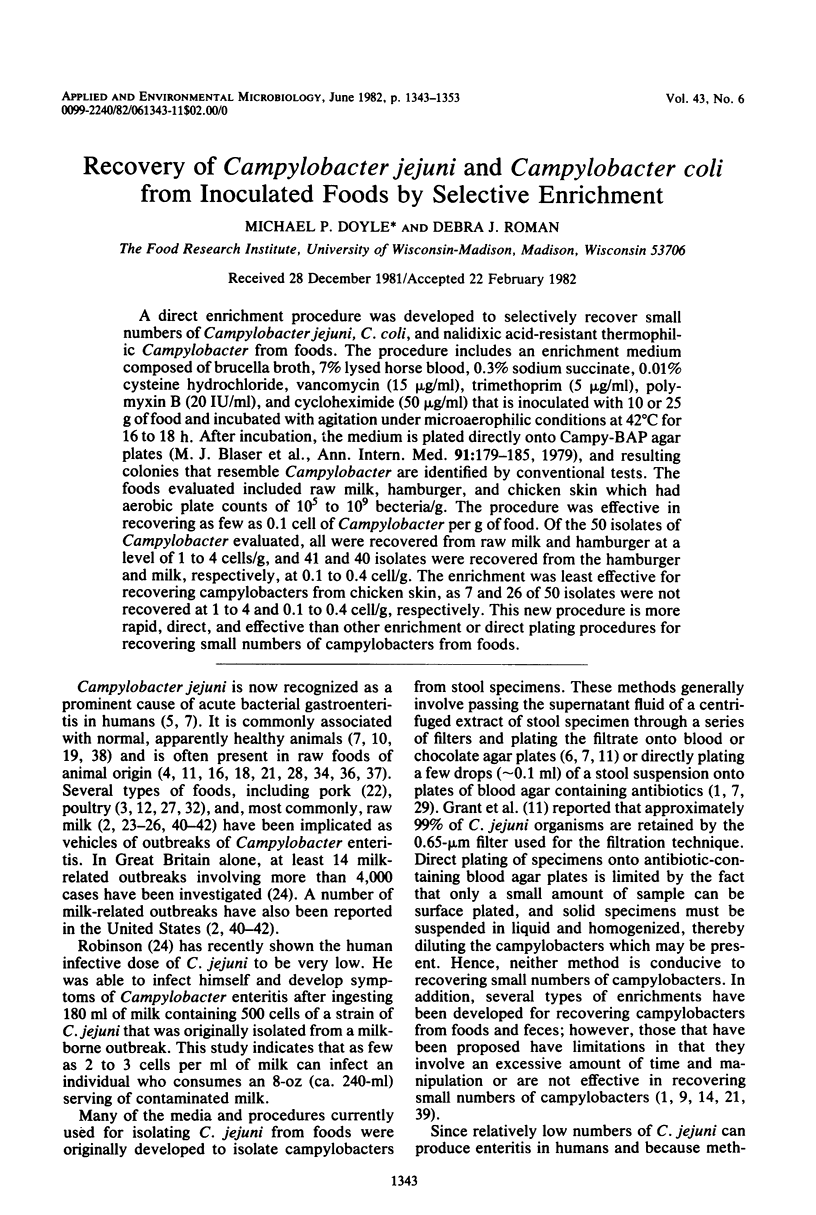
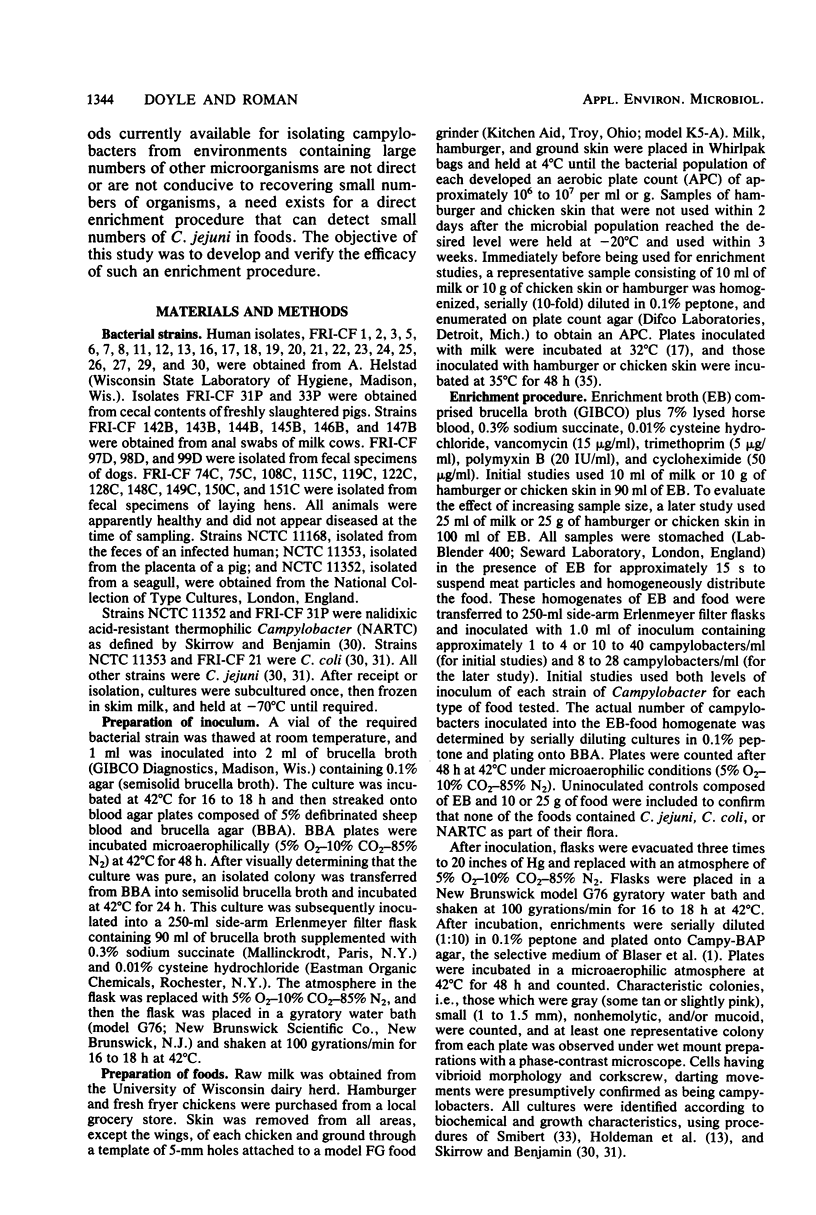



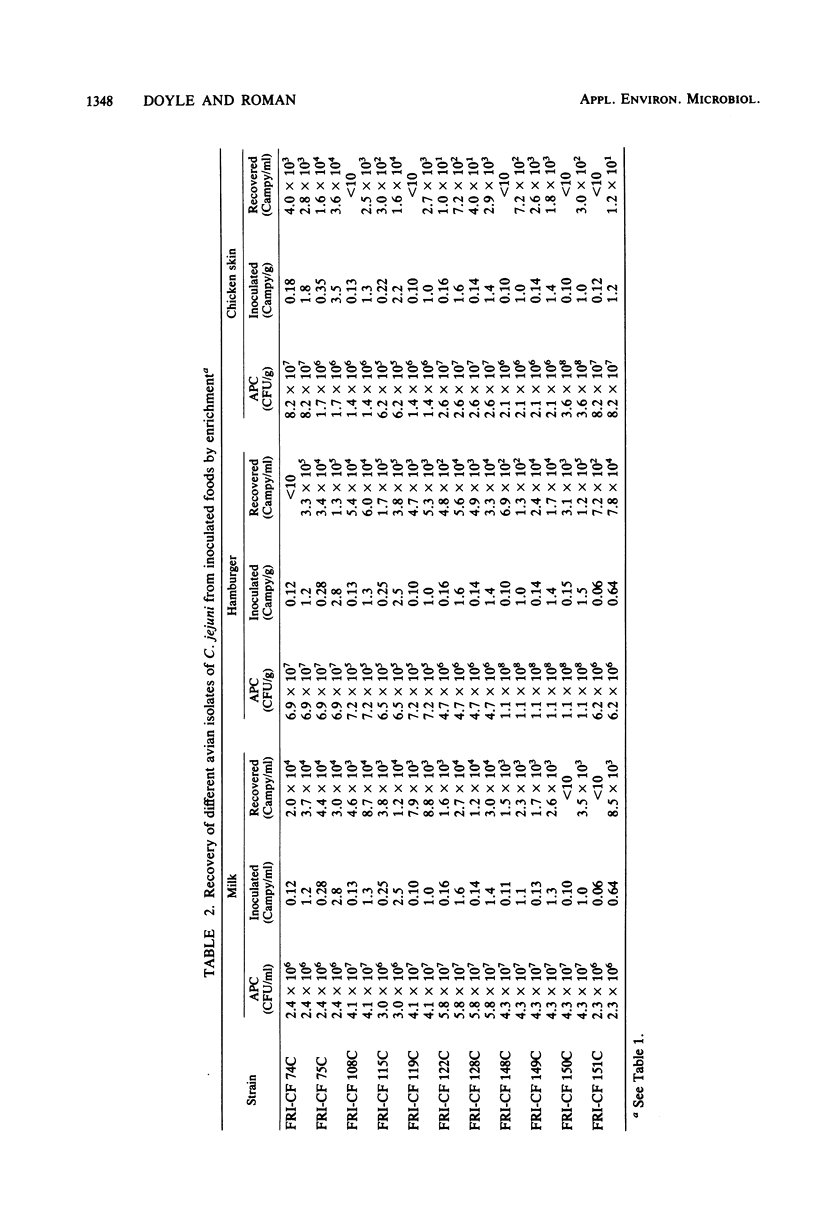
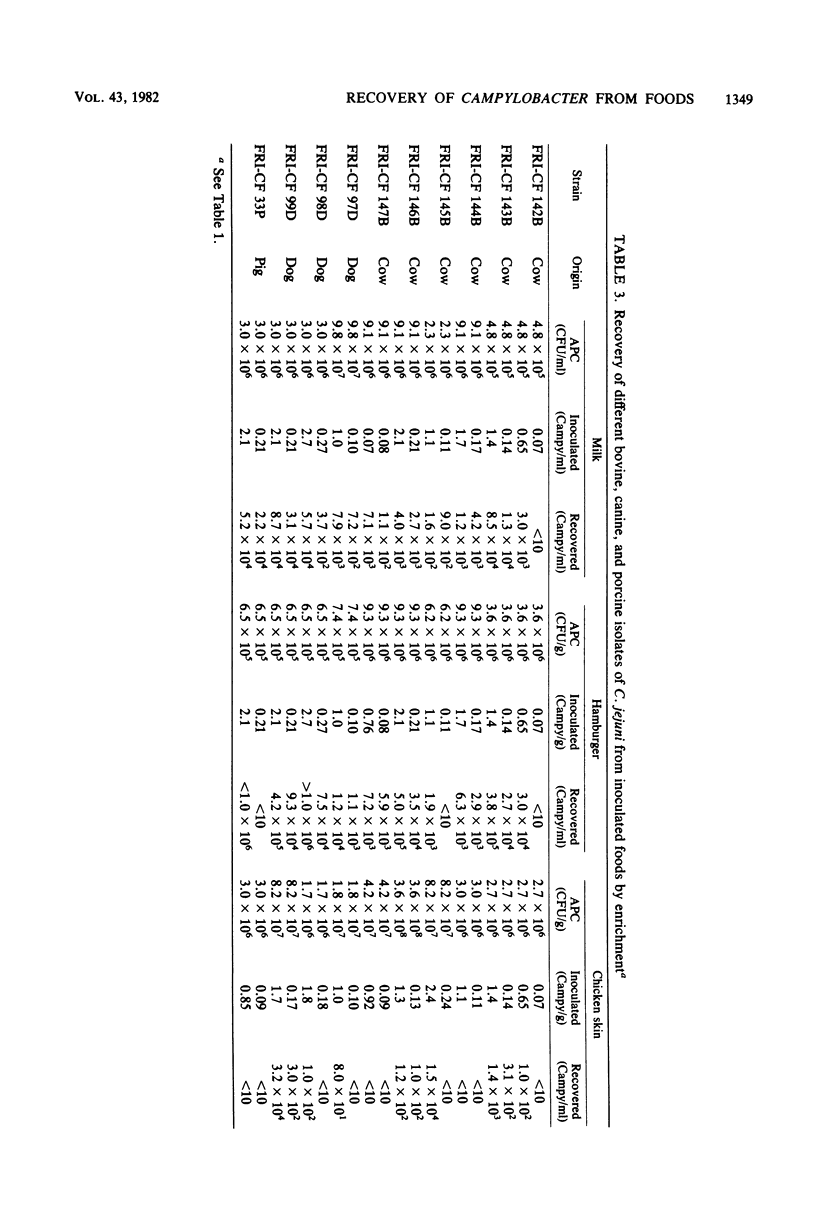

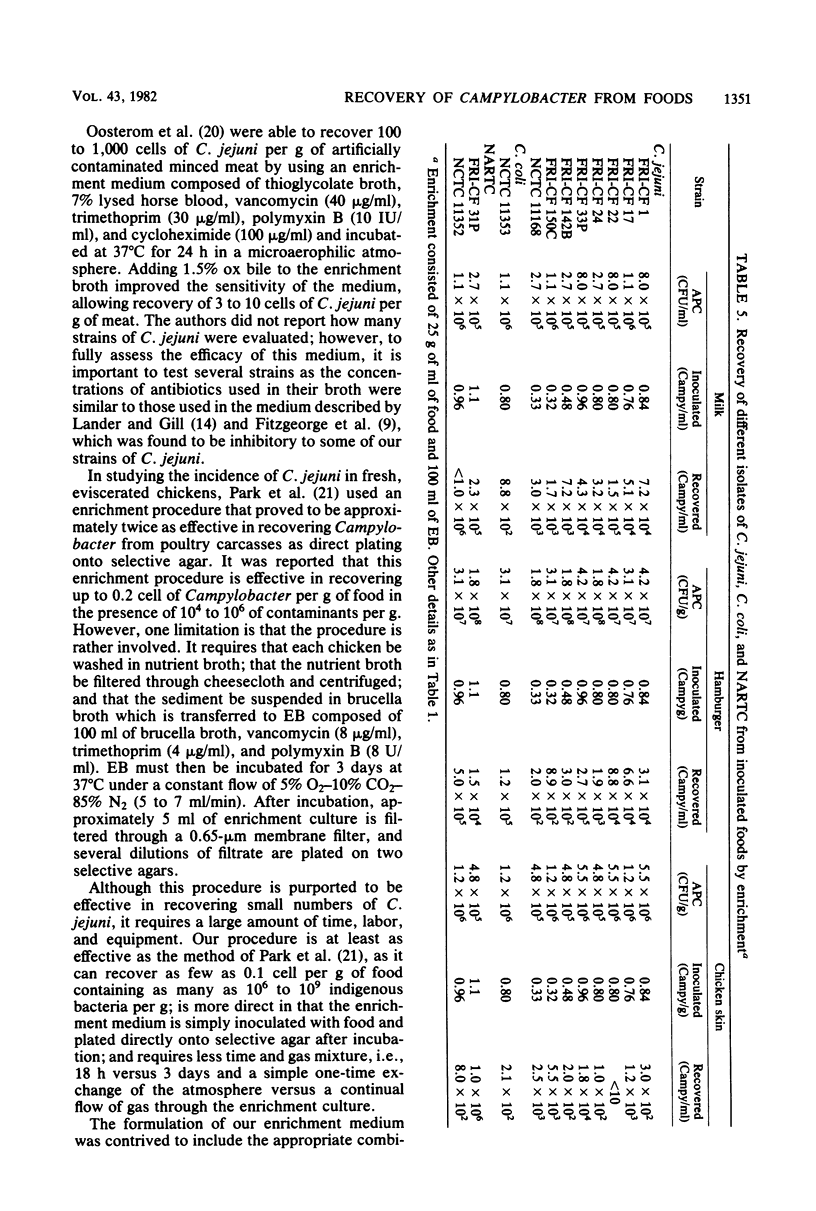


Selected References
These references are in PubMed. This may not be the complete list of references from this article.
- Blaser M. J., Berkowitz I. D., LaForce F. M., Cravens J., Reller L. B., Wang W. L. Campylobacter enteritis: clinical and epidemiologic features. Ann Intern Med. 1979 Aug;91(2):179–185. doi: 10.7326/0003-4819-91-2-179. [DOI] [PubMed] [Google Scholar]
- Blaser M. J., Cravens J., Powers B. W., Laforce F. M., Wang W. L. Campylobacter enteritis associated with unpasteurized milk. Am J Med. 1979 Oct;67(4):715–718. doi: 10.1016/0002-9343(79)90272-9. [DOI] [PubMed] [Google Scholar]
- Brouwer R., Mertens M. J., Siem T. H., Katchaki J. An explosive outbreak of Campylobacter enteritis in soldiers. Antonie Van Leeuwenhoek. 1979;45(3):517–519. doi: 10.1007/BF00443293. [DOI] [PubMed] [Google Scholar]
- Butzler J. P., Skirrow M. B. Campylobacter enteritis. Clin Gastroenterol. 1979 Sep;8(3):737–765. [PubMed] [Google Scholar]
- Dekeyser P., Gossuin-Detrain M., Butzler J. P., Sternon J. Acute enteritis due to related vibrio: first positive stool cultures. J Infect Dis. 1972 Apr;125(4):390–392. doi: 10.1093/infdis/125.4.390. [DOI] [PubMed] [Google Scholar]
- Fitzgeorge R. B., Baskerville A., Lander K. P. Experimental infection of Rhesus monkeys with a human strain of Campylobacter jejuni. J Hyg (Lond) 1981 Jun;86(3):343–351. doi: 10.1017/s0022172400069096. [DOI] [PMC free article] [PubMed] [Google Scholar]
- Goren E., de Jong W. A. Campylobacter fetus subspecies jejuni bij pluimvee. Tijdschr Diergeneeskd. 1980 Sep 1;105(17):724–726. [PubMed] [Google Scholar]
- Grant I. H., Richardson N. J., Bokkenheuser V. D. Broiler chickens as potential source of Campylobacter infections in humans. J Clin Microbiol. 1980 May;11(5):508–510. doi: 10.1128/jcm.11.5.508-510.1980. [DOI] [PMC free article] [PubMed] [Google Scholar]
- LECCE J. G. Some biochemical characteristics of Vibrio fetus and other related Vibrios isolated from animals. J Bacteriol. 1958 Sep;76(3):312–316. doi: 10.1128/jb.76.3.312-316.1958. [DOI] [PMC free article] [PubMed] [Google Scholar]
- Lander K. P., Gill K. P. Experimental infection of the bovine udder with Campylobacter coli/jejuni. J Hyg (Lond) 1980 Jun;84(3):421–428. doi: 10.1017/s0022172400026954. [DOI] [PMC free article] [PubMed] [Google Scholar]
- Luechtefeld N. W., Wang W. L. Campylobacter fetus subsp. jejuni in a turkey processing plant. J Clin Microbiol. 1981 Feb;13(2):266–268. doi: 10.1128/jcm.13.2.266-268.1981. [DOI] [PMC free article] [PubMed] [Google Scholar]
- Norberg P. Enteropathogenic bacteria in frozen chicken. Appl Environ Microbiol. 1981 Jul;42(1):32–34. doi: 10.1128/aem.42.1.32-34.1981. [DOI] [PMC free article] [PubMed] [Google Scholar]
- Oosterom J. Het voorkomen van Campylobacter fetus subspecies jejuni bij normale slachtvarkens. Tijdschr Diergeneeskd. 1980 Jan 1;105(1):49–50. [PubMed] [Google Scholar]
- Oosterom J., Vereijken M. J., Engels G. B. Campylobacter isolation. Vet Q. 1981 Apr;3(2):104–104. doi: 10.1080/01652176.1981.9693807. [DOI] [PubMed] [Google Scholar]
- Park C. E., Stankiewicz Z. K., Lovett J., Hunt J. Incidence of Campylobacter jejuni in fresh eviscerated whole market chickens. Can J Microbiol. 1981 Aug;27(8):841–842. doi: 10.1139/m81-129. [DOI] [PubMed] [Google Scholar]
- Peel R. N., McIntosh A. W. The dog it was that died. Lancet. 1978 Dec 2;2(8101):1212–1212. doi: 10.1016/s0140-6736(78)92209-2. [DOI] [PubMed] [Google Scholar]
- Porter I. A., Reid T. M. A milk-borne outbreak of Campylobacter infection. J Hyg (Lond) 1980 Jun;84(3):415–419. doi: 10.1017/s0022172400026942. [DOI] [PMC free article] [PubMed] [Google Scholar]
- Robinson D. A., Edgar W. J., Gibson G. L., Matchett A. A., Robertson L. Campylobacter enteritis associated with consumption of unpasteurised milk. Br Med J. 1979 May 5;1(6172):1171–1173. doi: 10.1136/bmj.1.6172.1171. [DOI] [PMC free article] [PubMed] [Google Scholar]
- Robinson D. A. Infective dose of Campylobacter jejuni in milk. Br Med J (Clin Res Ed) 1981 May 16;282(6276):1584–1584. doi: 10.1136/bmj.282.6276.1584. [DOI] [PMC free article] [PubMed] [Google Scholar]
- Robinson D. A., Jones D. M. Milk-borne campylobacter infection. Br Med J (Clin Res Ed) 1981 Apr 25;282(6273):1374–1376. doi: 10.1136/bmj.282.6273.1374. [DOI] [PMC free article] [PubMed] [Google Scholar]
- Skirrow M. B., Benjamin J. '1001' Campylobacters: cultural characteristics of intestinal campylobacters from man and animals. J Hyg (Lond) 1980 Dec;85(3):427–442. doi: 10.1017/s0022172400063506. [DOI] [PMC free article] [PubMed] [Google Scholar]
- Skirrow M. B., Benjamin J. Differentiation of enteropathogenic Campylobacter. J Clin Pathol. 1980 Nov;33(11):1122–1122. doi: 10.1136/jcp.33.11.1122. [DOI] [PMC free article] [PubMed] [Google Scholar]
- Skirrow M. B. Campylobacter enteritis: a "new" disease. Br Med J. 1977 Jul 2;2(6078):9–11. doi: 10.1136/bmj.2.6078.9. [DOI] [PMC free article] [PubMed] [Google Scholar]
- Skirrow M. B., Fidoe R. G., Jones D. M. An outbreak of presumptive food-borne campylobacter enteritis. J Infect. 1981 Sep;3(3):234–236. doi: 10.1016/s0163-4453(81)90819-7. [DOI] [PubMed] [Google Scholar]
- Smith M. V., 2nd, Muldoon P. J. Campylobacter fetus subspecies jejuni (Vibrio fetus) from commercially processed poultry. Appl Microbiol. 1974 May;27(5):995–996. doi: 10.1128/am.27.5.995-996.1974. [DOI] [PMC free article] [PubMed] [Google Scholar]
- Tanner E. I., Bullin C. H. Campylobacter enteritis. Br Med J. 1977 Aug 27;2(6086):579–579. doi: 10.1136/bmj.2.6086.579-a. [DOI] [PMC free article] [PubMed] [Google Scholar]
- Taylor P. R., Weinstein W. M., Bryner J. H. Campylobacter fetus infection in human subjects: association with raw milk. Am J Med. 1979 May;66(5):779–783. doi: 10.1016/0002-9343(79)91116-1. [DOI] [PubMed] [Google Scholar]
- Wang W. L., Blaser M., Cravens J. Isolation of campylobacter. Br Med J. 1978 Jul 1;2(6129):57–57. doi: 10.1136/bmj.2.6129.57-a. [DOI] [PMC free article] [PubMed] [Google Scholar]
- ZEMJANIS R., HOYT H. H. The effect of growth factors on the growth of Vibrio fetus. Am J Vet Res. 1960 Nov;21:1109–1113. [PubMed] [Google Scholar]


